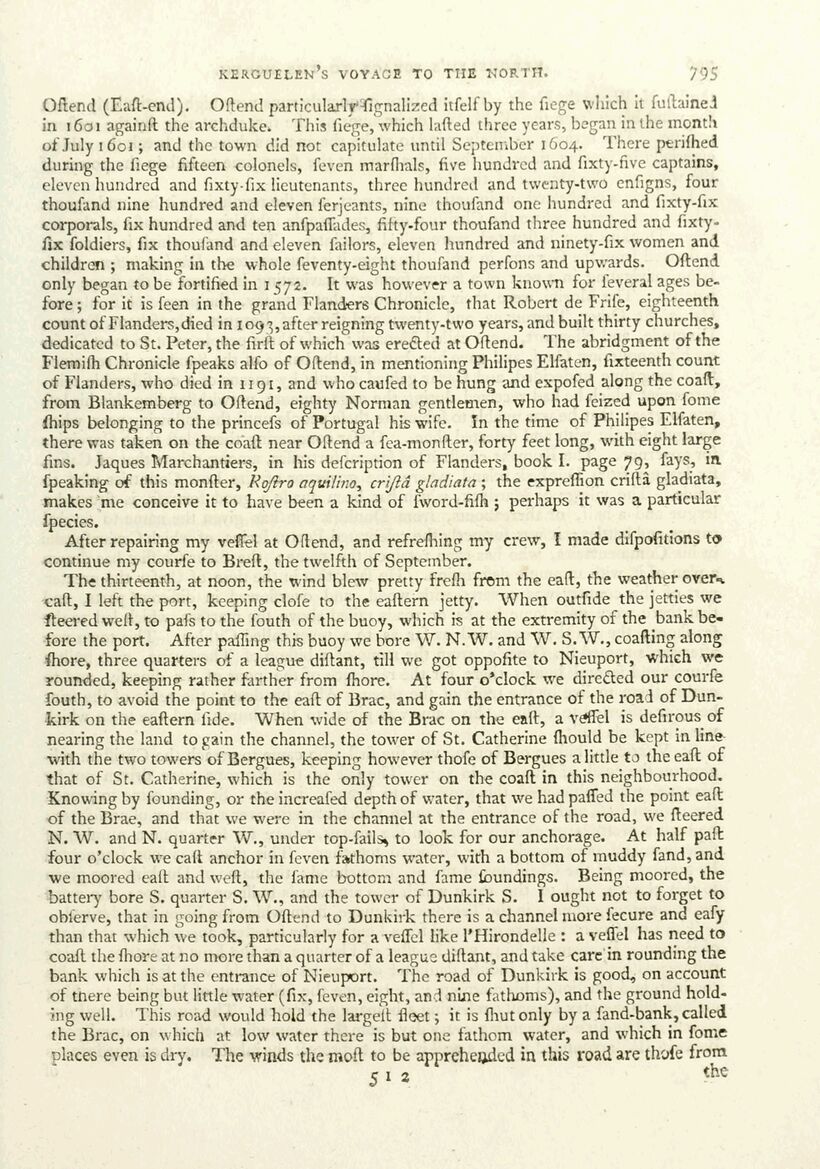
Full resolution (JPEG) - On this page / på denna sida - Pages ...

<< prev. page << föreg. sida << >> nästa sida >> next page >>
Below is the raw OCR text
from the above scanned image.
Do you see an error? Proofread the page now!
Här nedan syns maskintolkade texten från faksimilbilden ovan.
Ser du något fel? Korrekturläs sidan nu!
This page has never been proofread. / Denna sida har aldrig korrekturlästs.
KERGUELEN’S VOYACE TO THE NORTH. 795
Oftend (Eaft-end). Ostend particularlyfignalized itfelf by the fiege which it futtained
in 1601 againft the archduke. ‘This fiege, which lafted three years, began in the month
of July 1601; and the town did not capitulate until September 1604. There perifhed
during the fiege fifteen colonels, feven marfhals, five hundred and fixty-five captains,
eleven hundred and fixty-fix lieutenants, three hundred and twenty-two enfigns, four
thoufand nine hundred and eleven ferjeants, nine thoufand one hundred and fixty-fix
corporals, fix hundred and ten anfpaflades, fifty-four thoufand three hundred and fixty-
fix foldiers, fix thoufand and eleven failors, eleven hundred and ninety-fix women and
children ; making in the whole feventy-eight thoufand perfons and upwards. Oftend
only began to be fortified in 1572. It was however a town known for feveral ages be-
fore; for it is feen in the grand Flanders Chronicle, that Robert de Frife, eighteenth
count of Flanders, died in 103, after reigning twenty-two years, and built thirty churches,
dedicated to St. Peter, the firft of which was ereéted at Oftend. The abridgment of the
Flemifh Chronicle fpeaks alfo of Oftend, in mentioning Philipes Elfaten, fixteenth count
of Flanders, who died in 1191, and who caufed to be hung and expofed along the coatft,
from Blankemberg to Oftend, eighty Norman gentlemen, who had feized upon fome
fhips belonging to the princefs of Portugal his wife. In the time of Philipes EMaten,
there was taken on the coaft near Oftend a fea-montter, forty feet long, with eight large
fins. Jaques Marchantiers, in his defcription of Flanders, book I. page 79, fays, in
{peaking of this monfter, Rofro aquiline, crifté gladiata; the expreffion crifta gladiata,
Aree ‘me conceive it to have been a kind of {word-fifh ; perhaps it was a particular
pecies.
After repairing my veffel at Oftend, and refrefhing my crew, I made difpofitions to
continue my courfe to Breft, the twelfth of September.
The thirteenth, at noon, the wind blew pretty frefh from the eaft, the weather overs
att, I left the port, keeping clofe to the eaftern jetty. When outfide the jetties we
fteered welt, to pafs to the fouth of the buoy, which is at the extremity of the bank bee
fore the port. After pafling this buoy we bore W. N. W. and W.S.W., coafting along
fhore, three quarters of a league diftant, till we got oppofite to Nieuport, which we
rounded, keeping rather farther from fhore. At four o’clock we directed our courfe
fouth, to avoid the point to the eaft of Brac, and gain the entrance of the road of Dun-
kirk on the eaftern fide. When wide of the Brac on the eaft, a veffel is deftrous of
nearing the land to gain the channel, the tower of St. Catherine fhould be kept in line
with the two towers of Bergues, keeping however thofe of Bergues alittle to the eaft of
that of St. Catherine, which is the only tower on the coaft in this neighbourhood.
Knowing by founding, or the increafed depth of water, that we had paffed the point eaft
of the Brae, and that we were in the channel at the entrance of the road, we fteered
N. W. and N. quarter W., under top-fails to look for our anchorage. At half paft
four o’clock we caft anchor in feven fathoms water, with a bottom of muddy fand, and
we moored eaft and weft, the fame bottom and fame foundings. Being moored, the
battery bore S. quarter S. W., and the tower of Dunkirk S. I ought not to forget to
obferve, that in going from Oftend to Dunkirk there is a channel more fecure and eafy
than that which we took, particularly for a veffel like ’’Hirondelle : a veffel has need to
coat the fhore at no more than a quarter of a league diftant, and take care’in rounding the
bank which is at the entrance of Nieuport. The road of Dunkirk is good, on account
of there being but little water (fix, feven, eight, and nine fathoms), and the ground hold-
ing well. This road would hold the large(t fleet ; it is fhut only by a fand-bank, called
the Brac, on which at low water there is but one fathom water, and which in fome
places even isdry. The winds the moft to be apprehended in this road are thofe ee
512 tne
<< prev. page << föreg. sida << >> nästa sida >> next page >>